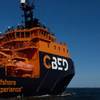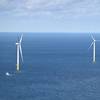Global Marine’s worldwide SCORE, or Summary of Current Offshore Rig Economics, for September 2000 increased 1.8 percent over the previous month. Global Marine Chairman, President and CEO Bob Rose said, “September marks the 13th consecutive month of improvement in the worldwide SCORE and the 15th consecutive month of improvement in the Gulf of Mexico SCORE. With worldwide offshore drilling rig utilization at 80 percent, commodity prices strong, and customer inquiries about extended drilling programs in international locations on the rise, we appear to be well poised to see a continued worldwide strengthening of offshore rig markets.”
Global Marine’s SCORE compares the profitability of current mobile offshore drilling rig rates to the profitability of rates at the 1980-81 peak of the offshore drilling cycle, when speculative new rig construction was common. In the 1980-81 period, when Global Marine’s SCORE averaged 100 percent, new-contract dayrates equaled the sum of daily cash operating costs plus approximately $700 per day per million dollars invested. In addition to a worldwide SCORE covering key types of competitive offshore drilling rigs in key drilling markets, a separate SCORE is calculated for certain types of rigs and certain regions to indicate the relative condition of rig markets.
Worldwide
The September worldwide SCORE for all types of offshore drilling rigs increased 1.8 percent to 33.8 from 33.2 in August. The September 2000 SCORE represents a 46.6 percent increase from September 1999 and a 23.6 percent decrease from the same period five years ago.
Gulf Of Mexico
Global Marine’s September SCORE for the U.S. Gulf of Mexico increased 1.3 percent to 38.9 from August’s 38.4. The September 2000 SCORE is 72.2 percent above September 1999 and 4.1 percent above its level five years ago.
The North Sea
The North Sea SCORE of 24.9 increased 1.3 percent from September 2000. The region’s SCORE is up 20.0 percent for the one-year period and down 53.2 percent for the five-year period.
West Africa
West Africa’s September SCORE of 39.5 increased 1.7 percent from August 2000. This region’s SCORE is 34.2 percent above its level in September of last year, and 2.8 percent above its level five years ago.
Southeast Asia
Southeast Asia’s September 2000 SCORE of 34.7 is 6.6 percent above its prior month level, 18.9 percent above its level in September 1999, and 24.5 percent below its level five years ago.
Jackups
With a 1.1 percent increase from August 2000, the 41.9 SCORE for jackups has increased 84.0 percent from a year ago, but remains 4.7 percent below its level five years ago.
Semisubmersibles
The September SCORE of 25 percent for semisubmersibles is 1.4 percent above its level in September 2000. The SCORE for semisubmersibles has increased 7.3 percent from its level one year ago, and remains 43.6 percent below its level five years ago.
Coflexip Says Aker is Best Buy Available
French oil services firm Coflexip Stena Offshore purchased Aker Maritime’s U.S.-based deepwater division in a $513 million transaction Coflexip officials called the company’s best opportunity to strengthen its business.
Coflexip said the takeover would strengthen its presence in deepwater markets, particularly the Gulf of Mexico, enable it to offer a complete range of technologies - excluding seismic tests and drilling which did not currently interest it - and give it access to U.S. oil majors whose deep offshore centers were based in Houston alongside Aker’s deepwater unit.
Coflexip officials said the deal, which will cost it $625 million including assumed net debt of $112 million, offered up to $30 million in synergies - costs and revenue - in earnings before interest, taxation, depreciation and amortization by 2003.
Deputy managing director Tom Ehret said Coflexip hoped to achieve 15 percent of the synergies in 2001, 25 percent by 2002 and 100 percent by 2003, adding that the transaction offered “extraordinary leverage for obtaining supplementary revenue”.
Coflexip - which recorded diluted earnings per share (EPS) of $5.02 in 1999 - said the merger should improve EPS before goodwill by over 10 percent in 2001 and over 20 percent in 2002. Coflexip chairman Pierre Marie Valentin said that while Aker, like Coflexip, had suffered from the recent slump in oilfield investments, it was expected to revive in 2001. Orders, which would be worth $400 million in 2000, were already strong for 2001 and included three SPAR rigs. He said the acquisition, financed from Coflexip’s own funds and new credit lines, would leave the company with a debt to equity ratio of 30 to 35 percent by mid-2001.
Analysts said the Aker buy would turn Coflexip into a major player in the market for building deepwater rigs - expected to be worth $19 billion in 2000 and $30 billion in 2004, against some $3-4 billion for Coflexip’s core oil services business.
The deal is expected to boost Coflexip’s presence in markets where demand for deep offshore rigs is poised to grow strongly, namely the Gulf of Mexico, Caspian Sea and West Africa.
Valentin said French peer Technip , which holds 29.7 percent of Coflexip, would be offered a 20-percent stake in Aker’s deepwater unit once the buy was completed next January.
Subscribe for
Maritime Reporter E-News
Maritime Reporter E-News is the maritime industry's largest circulation and most authoritative ENews Service, delivered to your Email five times per week










